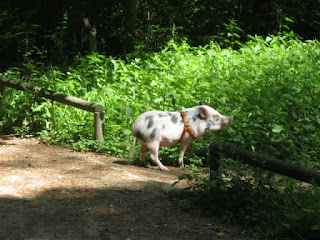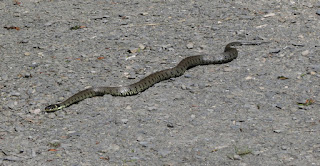If you want to see a Goshawk, go to Berlin.
I’d just spent a few days in Baden-Wurttemberg visiting my
brother and my German sister-in-law and had already seen such species as
Fieldfare (distinctly out of place in baking late May), Serin and many, many
Black Redstarts but I was now in the big city and looking to get my birding
bearings.
 |
| Sparrow art |
|
|
|
First of all, House Sparrows are everywhere and are quite
forward, jumping on to your café table in search of crumbs and clearly making a
mark on the local graffiti artists.
As previously alluded to, Black Redstarts are also very
common, seemingly swapping places with the Robin in terms of numbers and
behaviour, one’s attention frequently being drawn to their ‘electric river’
song, and the Hooded Crow rules the roost over our more usual Carrion Crow.
They also seem rather territorial as I was buzzed twice by one before I beat a
hasty retreat.
|
|
 |
| Hooded crow |
|
|
My main Berlin birding area was the Tiergarten, a beautiful
park to the west of the Brandenburg Gate. It's the former hunting park, with winding paths, islands, pondsa an as lake. On the lake mute swans and mallards were the home birds.
|
|
|
 |
| Queen Louise, beloved queen of the Prussians |
|
Taking care not to be run over by the many cyclists I heard
the usual warblers chff chaff and willow warbler etc but many, many ‘chipping’ woodpeckers, including one
chasing another right in front of me. I thought they were all Great Spotted but
this site seems to indicate that Middle Spotted may also be around https://germanybirding.com/ so a little
ID brushing up may well end up paying off.
My most unusual sighting on my first visit was this little
fellow who, judging by his harness, was a pet:
|
|
 |
| Pet Pig |
|
|
It was very, very hot so, after being disappointed to find
the English Tea Garden closed, I made for the Café Tiergarten on Altonauer
Strasse, whose garden gave out over the edge of the Tiergarten, enabling me to
see a GSW alighting on a nearby tree, yet more Black Redstarts and a single
Common Redstart (I’ve deliberately left the tape in the photo as this part of
the field seemed to be where all the action was):
|
 |
| Redstart |
|
|
|
Another site that repaid a visit was an unexpected one – Gatow airfield is now
a museum and I’d gone to have a look at their old aircraft.
I had to be careful not to make any sudden movements as it
seemed the local Black Redstarts had developed missile technology:
|
|
 |
| Black Redstart |
|
|
Finally, at the very end of the fighter section stood this old Sukhoi fighter:
|
|
 |
| Sukhoi |
|
|
And, sat on the corner of the fence to the left was… a Grey
Shrike! It stayed put long enough for me to tell it was a Grey Shrike but,
though I had the Collins on me this time, not long enough for me to
definitively determine that it was a GGS as opposed to a Lesser before it flew
behind some containers and lorries behind said fence.
I’ve posted the question on birdforum.net and, judging by the their responses
and https://germanybirding.com/ , it
would appear that it was indeed another Great Grey Shrike which is my second in
under three months. Crazy times!
In the end the closest I came to seeing a Goshawk was when
sitting at Friedrichstrasse S-Bahn station and seeing a boat called ‘Habicht’
go by. ‘Habicht’ is German for Goshawk, and it was encouraging to see that the
locals are aware of nature’s goodies on their very doorstep.
If anyone’s considering a Berlin trip then I heartily
recommend it – history everywhere you look and enough green spaces to break up
the sightseeing, with the added attraction that, for most of us, Germany is
very much an under-visited and under-watched country from a birding
perspective.
 |
| Tiergarten Lake |
John Doragh




















